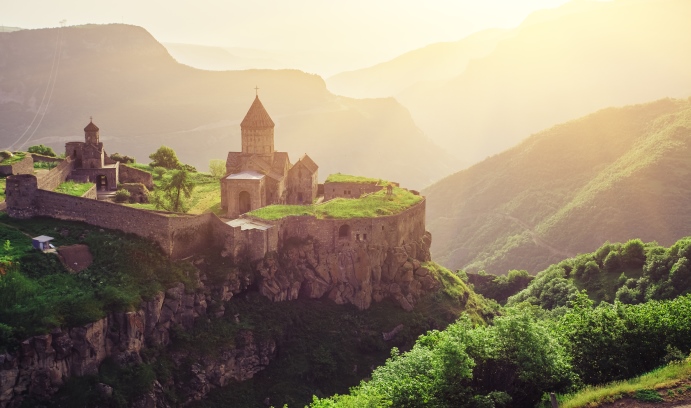An Armenian Peace Prescription

The Tatev Monastery, a ninth-century Armenian Apostolic monastery, is located in southeastern Armenia. In his recent book, Arman Grigoryan explored the obstacles to Armenia’s democratic transition. (Image by iStock-Volodymyr Goinyk)
The political career of Levon Ter-Petrossian, says Arman Grigoryan, has been defined by his struggle for a democratic Armenia and for an Armenia at peace with its neighbors. Ter-Petrossian served as Armenia's first post-Soviet president from 1991-98 and is now the chairman of the Armenian National Congress, country’s leading opposition party.
Grigoryan, assistant professor of international relations, is editor of Armenia’s Future, Relations with Turkey, and the Karabagh Conflict, which was published in September by Palgrave Macmillan. The new book, a collection of Ter-Petrossian’a articles, speeches and interviews from 1990 to 2016, is the first compilation of his writings from this period to appear in English translation.
Grigoryan, who served in Armenia’s government from 1991-93, says the book provides a unique window into the political transformations of 1990-2016 and the issues that have plagued Armenia’s politics since its independence.
“Ter-Petrossian is not a mere politician but also a statesman and an intellectual who led a process of transforming the political discourse in Armenia,” says Grigoryan. “In particular, he targeted many of the calcified dogmas of the traditional Armenian nationalist narrative, especially the dogmas related to Armenia’s relations with Turkey and Azerbaijan.”
Grigoryan said Ter-Petrossian’s collected writings also forcefully respond to the popular view among Western journalists and academics that clashing ethnic identities and historical hatred are at the root of the Karabagh conflict and the cold war with Turkey.
In the foreword to Armenia’s Future, Grigoryan addresses Ter-Petrossian’s detractors in Armenia and the Armenian diaspora:
“The overarching theme in all of these arguments,” he writes, “is that Armenians have to begin to think and act like a people with a state, rather than a stateless ethnic group, and that doing so requires pragmatism, rational calculation, and rejection of historic grievances, including the ideology of the Armenian Cause, as a basis of politics.”
The stakes of this struggle, Grigoryan argues, are nothing less than Armenia’s future and its ability to fulfill its potential as an independent, democratic nation.
“Armenia’s chances of becoming a ‘normal state’ [versus a state bound by ‘national ideology’],” he concludes in the foreword, “are closely tied to normalization of relations with its neighbors. The alternative is a state where every democratic challenge is menacingly described as a threat to unity, where the public even refrains from issuing such challenges lest it whets the enemy’s appetite, and where the defense minister is seriously pushing the idea of turning the nation into an army.”
Grigoryan gave a presentation on the topic earlier this year in Los Angeles during a conference titled “End of Transition: Armenia 25 Years On, Now What?” The conference, hosted by the University of Southern California’s Dornsife Institute of Armenian Studies, brought together notable names in media, government, academia and the arts to explore demographic changes, transitions in social and economic policy, the development of formal and informal political and social institutions, bottom-up social change and civil society formation, and the foreign policy challenges Armenia is dealing with.
Grigoryan is exploring the broader topic of war and democratic transition in an upcoming book.
Posted on:





